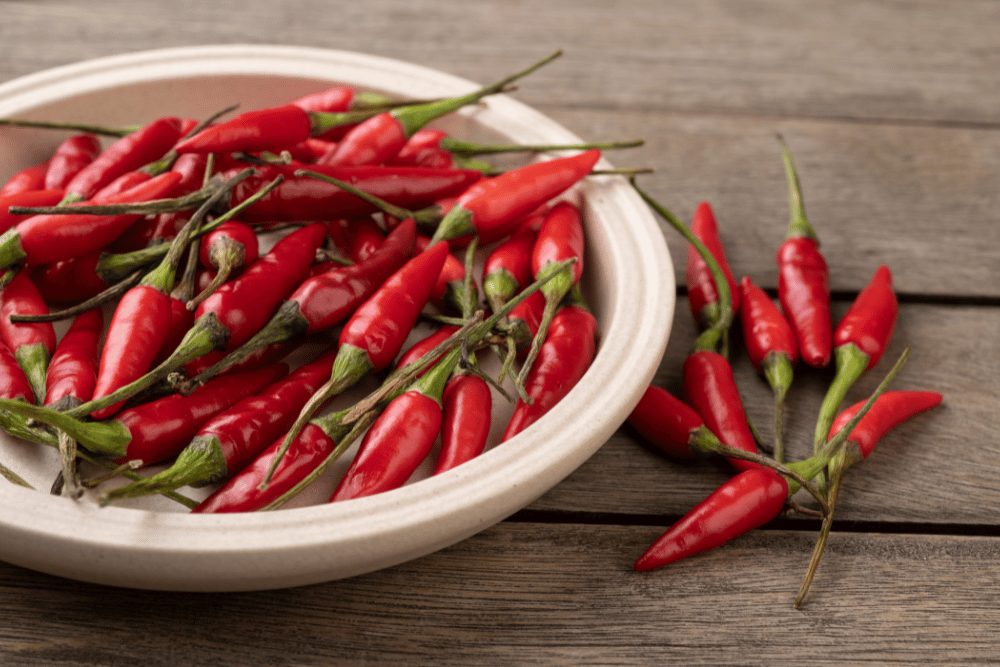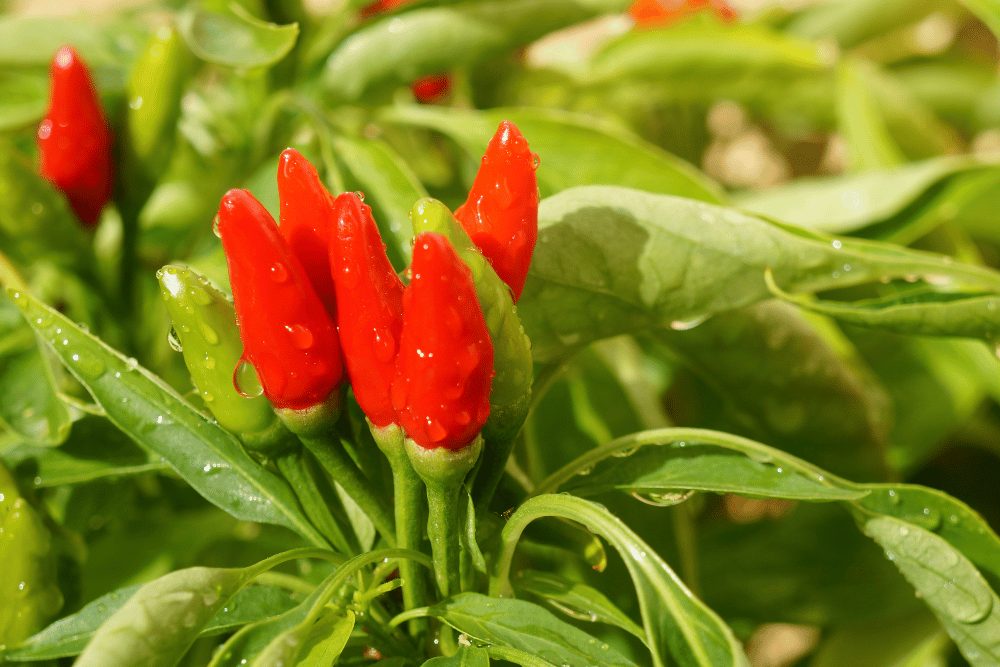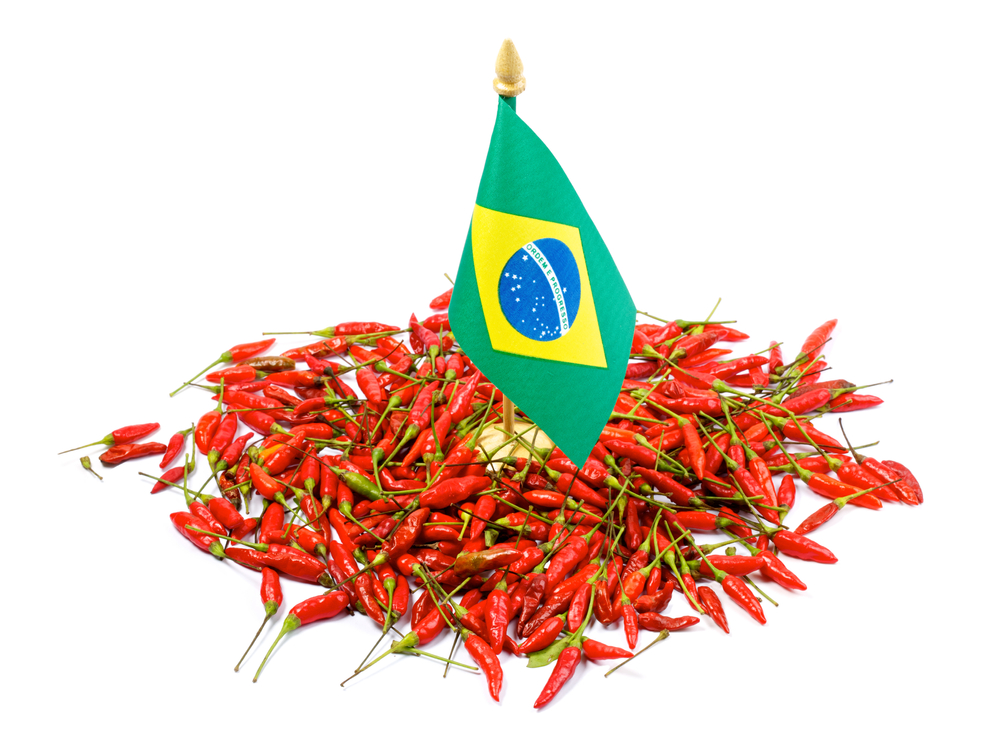Malagueta peppers are staple chilis in Brazilian and Portuguese cuisines because of their mild to medium heat and sweet, fruity flavor. They are commonly grown in Portugal and her former colonies, where they are known for their high yields and upright growth.
What Is A Malagueta Pepper?
Malagueta peppers are small chili peppers in the Capsicum frutescens species widely used in Caribbean, Portuguese and Brazilian cuisines for their heat and citrusy flavor.
Malagueta peppers borrow their name from melegueta peppers—a West African spice liked by Portuguese traders as a black pepper substitute.
Malagueta chiles are often confused with the cardamon-like melegueta pepper, also called “grains of paradise.”
The Portuguese traders named malagueta peppers this way because the spiciness resembled melegueta rhizome seeds.

Origins
Malagueta peppers are believed to have been one of the pepper varieties brought during the Columbian Exchange by Portuguese explorers and spice traders into Portugal and Portuguese colonies like Brazil, Mozambique, Angola, and São Tomé and Principe.
The small peppers are grown in the Caribbean and widely in northern South America in Peru and Brazil.
Malagueta pepper varieties native to Brazil and Peru have been recognized in the Ark of Taste as aji malagueta by the Slow Food Foundation as family-level heirloom peppers.
Other Names
Malagueta peppers go by different names in different regions, depending on their size, age, and location.
- In Portugal, they are called pimenta malagueta (“pimenta” being the Portuguese word for “chile” or “chili”).
- In Peru and parts of Brazil, they are called aji malagueta (“aji” being a Spanish dialect word for “chile pepper”).
- Smaller malagueta peppers that are harvested young are called malaguetinha in Brazil. They are also called piri piri (a Swahili word) in Mozambique and Portugal.
- Larger malagueta peppers harvested older are called malaguetão in Brazil or malagueta in Portugal and Brazil.
- In Cape Verde, they are called margueta and malgueta in the Cape Verdean Creole language.
Size And Shape
Malagueta chili peppers are small—only about two inches long at full maturity.
They are available in food markets in two sizes, depending on the harvesting stage. The smaller ones are harvested when young, while the larger ones grow to full maturity.
The peppers have a tapered, conical shape similar to Thai chilis or bird’s eye chilis.
Color
Like most other chile peppers, malaguetas start green and ripen to deep red. The red color and shortness of the pods explain why they are likened to bird’s eye chili and Thai chili.
Texture
When fresh, malagueta peppers have a thin, glossy skin. The skin becomes papery and easy to crush when dried.
Unusual Growth Behavior
The malaguetas aren’t your typical pepper in growth behavior—they proudly grow upright, much like black cobra peppers.

What Does A Malagueta Pepper Taste Like?
The malagueta pepper has a sweet, citrusy, but bitter flavor. Its fruity flavor is akin to berries, and it registers on the tongue first before the heat kicks in.
How Hot Is Malagueta Pepper?
At 60,000-100,000 Scoville Heat Units, malaguetas are hot peppers in the medium heat range. The malaguetas are two times hotter than cayenne and tabasco peppers, which both register 30,000-50,000 SHUs.
Compared to the usual jalapenos with 2,500-8,000 SHUs, malagueta peppers are 12.5 to 24 times spicier.
Can You Eat Malagueta Peppers?
Yes! Malagueta peppers are safe for you in raw, dried, and cooked forms.
If you’re sensitive to heat, start with a small amount. You can always add more, but it’s difficult to dilute or cover up the heat if you use too much.
How Do You Use Malagueta Peppers?
Malagueta chili peppers are typically used to flavor regional and traditional dishes in Brazilian, Portuguese, and Mozambican cuisines. In Portugal, they are a beloved seasoning for poultry dishes.
Besides seasoning regional dishes from the mentioned countries, you can use malagueta peppers in many ways:
- Making malagueta hot salsa, malagueta hot sauce, and hot condiments.
- In fruit and tomato-based sauces and salsa.
- As a topping for pizza when red malaguetas are dried and crushed.
- Making malagueta pepper puree.
- Making malagueta mash, which is malagueta peppers ground together with the seeds and membrane. The mash can be used to make hot sauces, as a condiment, or in any recipe like a chili paste.
- Cooking into soups, stir-fries, and stews featuring white meats and vegetables.
- As pickled peppers soaked in vinegar. The soaking solution is called “vinegar brine with malagueta peppers” and is a common spice in Brazil.
- As preserved peppers in oil, brandy, garlic, and ginger. The flavor-infused oil can be used to drizzle over dishes.
- Blend with vinegar to make traditional Brazilian sauce.
Where To Buy Malagueta Peppers
You can easily find malagueta peppers in local markets in Portugal and the Portuguese colonies mentioned earlier. The peppers are hard to find outside these countries, especially in standard supermarkets.
Many online outlets like Amazon sell malagueta hot sauce. Try it before growing your own malaguetas.
The malagueta chile is increasingly becoming popular in the US, so you may be able to find fresh and dried peppers in specialty Latin stores or farmers’ markets.
How Are Malagueta Peppers Grown?
Malagueta hot chili plants can be established in gardens or containers from pepper seeds bought online.
Malaguetas thrive best in direct sun in hot, humid areas where the soil is damp, fertile, and well-drained. Start your seeds indoors several weeks before the last frost and transplant them outdoors after the last frost has passed.
Since it doesn’t do well in cold conditions, the malagueta pepper is best grown in containers you can move indoors during cold times if you plan to grow them as a perennial.
Malagueta pepper plants are prolific. Expect up to 100 pods per well-fed plant.
Substitutes For Malagueta Peppers
Malagueta peppers can’t be considered rare, seeing how they are spread in South America, the Caribbean, and some African countries. However, you’ll need substitutes since you might not find them in the US and other countries.
Tabasco and cayenne peppers make excellent malagueta substitutes but are milder and have varying flavor profiles.
You can also try African bird’s eye chili.

